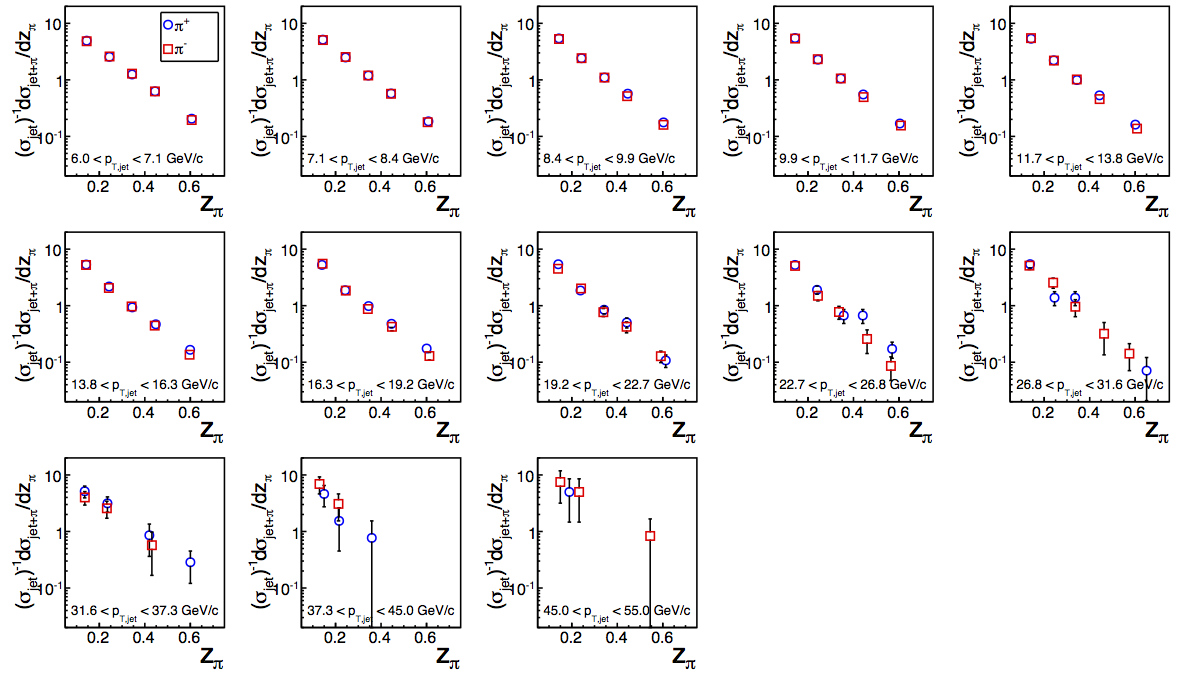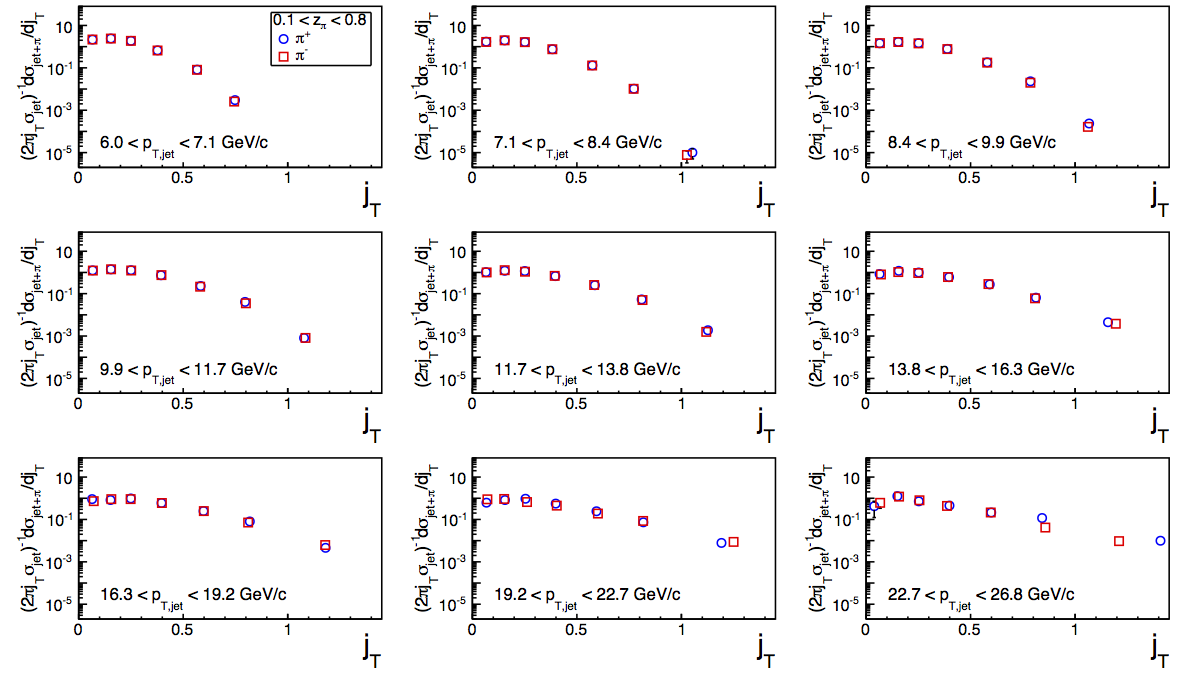2011 Fragmentation Function: First Look
Target Physics
Kaufmann, Mukherjee, and Vogelsang have posted a new paper on fragmentation functions of pions within jets. One of the proposals is to utilize data to constrain the gluon fragmentation function. While the cross section measurement would require considerable work to fix the absolute scale, the multiplicity measurement (e.g. Fig. 6) is far more straightforward.
Proposal
The proposal, here, is to use the 2011 dataset analyzed for the Collins asymmetry to measure the multiplicity of pions within jets. One of the most unique aspects of the 2011 data is the prevalence of minbias events at lower jet pT which should yield acute sensitivity to gluons. The minbias events also have the nice feature of removing trigger bias. Thus, the present proposal focuses on the VPDMB data. The 2012 dataset should provide much better sensitivity to quarks.
A summary of a few notes from Carl:
- This measurement is very similar to a cross section. The largest difference is that the present measurement does not require the absolute luminosity. The final results will be dominated by the tracking efficiency uncertainty, which will be ≈100% correlated across all bins. Since the sysetmatic uncertainties will dominate, it seems sacrificing statistics to improve sysetmatics makes the most sense. Thus, at least at first, the proposal is to restrict to |η| < 0.5. This will provide a very uniform track and calorimeter acceptance for all jets.
- Since, for gluons, low-pT jets are the primary interest, and furthermore since that is where the data have the largest statistical sensitivity, it should be worthwhile to bin those data finely in pT. This should also help make the unfolding more stable. At high-pT, statistics are quite limited, therefore, coarser bins make more sense. In the fullness of time, that physics will be done far better with high-pT jets from the 2012 200 GeV dataset.
- It is not at all clear how the unmatched jets will distort the measured fragmentation distributions. So, in contrast to AUT, they cannot be treated as a simple dilution systematic. Thus, we may need to stay away from the region with significant fraction of unmatched jets, or otherwise utilize a method to exclude underlying event contaminations.
- For the lower pT bins, the 0.6 < z < 0.8 bins are terra incognita for the current generation of fragmentation functions. For the highest pT bins it is likely best to avoid them.
- The present measurement will definitely need an unfolding. It is worth noting that the track pT resolution is much better than the jet pT resolution. So, the primary role for the unfolding will be to correct the jet pT smearing. It may be that the unfolding will best be done as a simultaneous 2-D treatment for z and pT.
- Unlike the AUT measurement, the ΔRmin cut is unnecessary and can be removed.
Prospects
The following figures are quite raw. Plotted are the π+ (blue circles) and π- (red squares) z-distributions scaled by the number of jets within the relevant pT bin. The yields are also scaled by the z-bin widths. The points are plotted at the bin averages. Therefore, no corrections are applied for efficiencies or bin-shifting with no unfolding applied. Further, no background corrections are applied. Uncertainties (typically too small for the current scale of the plots) are only statistical with no systematics included. The plots are intended solely to give a sense for what may be available from the 2011 dataset.
Figure 1

Figure 1 shows the multiplicities in z for each of the available pT bins. It is clear that sufficient statistics are available for each of the bins from 6-16.3 GeV/c and probably also for the next 2-3 bins. However, above 22.7 GeV/c the yield drops rather quickly. The high-pT physics is probably best left to 200 GeV, anyway. It is probably best to leave the 22.7-26.8 GeV/c bin as a buffer for unfolding and report only pT < 22.7 GeV/c for the result. The 6-7.1 GeV/c bin may also be contaminated by unmatched jets to the point where it is not useful for the physics message. However, it could still be useful as a buffer bin for unfolding. An additional set of 0.05 < z < 0.1 bins may also be useful as unfolding buffers, if not also for physics.
Figure 2

Figure 2 shows the same data from Fig. 1 but now restricting to the proposed binning. For the last few bins it may be best to drop the highest z bins or else use them only as buffers. Up until now, we have not utilized VPDMB above 16.3 GeV/c since the trigger data have provided substantially more yield. However, here, the triggered data are not as useful due to trigger bias. The existing embedding should be sufficient to cover the proposed binning. The current three highest pT bins are not crucial to the physics message of the present measurement. Providing xT overlap with a follow-up measurement from 200 GeV will allow sensitivity to fragmentation function Q2 evolution.
Figure 3

Figure 3 shows the jT dependence of the multiplicities over the range 0.1 < z < 0.8. While this presentation will not be useful for the collinear framework with which Werner and Co. are concerned, it could be quite useful for the TMD framework under so much investigation, these days. In the fullness of time, we would further propose showing the 2-D dN/dzdjT distributions for a few bins of pT. These would prove quite useful in disentangling z-jT correlations.
- drach09's blog
- Login or register to post comments
